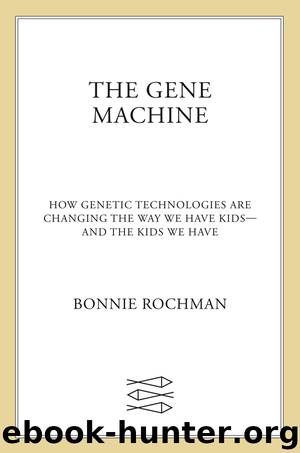The Gene Machine by Bonnie Rochman

Author:Bonnie Rochman
Language: eng
Format: epub
Publisher: Farrar, Straus and Giroux
6
The Right to an Open Future
Navigating the Return of Results
In 2010, Mike Bamshad, the chief of pediatric genetic medicine at the University of Washington, co-led a team that was the first to sequence the DNA of an entire family—a mother, a father, and their two grown children—to find the cause of their condition. The researchers succeeded in pinpointing the gene that was responsible for Miller syndrome, a condition that caused the limb deformities and recessed chins of Debbie Jorde’s two children. In accordance with standard research protocol, they engaged in the time-consuming task of obtaining formal consent from the family to share with them each potential finding. But once the results came back, the researchers were frustrated by the cumbersome process of returning those results, one by one. Complicating matters was a secondary, or incidental, finding—primary ciliary dyskinesia, a condition that resembles cystic fibrosis. As Bamshad recalls, some family members wanted some results and others wanted different ones, and some of their preferences evolved over time. Bamshad figured there had to be a more efficient way for people being sequenced to select their preferences and receive their results.
In the past, Bamshad would have performed a particular genetic test on a child and the family would come back to the clinic to get the result—testing one gene would yield one result. But sequencing scans all 19,000 or so of a person’s genes. With sequencing moving toward the mainstream, the deluge of data generated from each sequencing test would mean that no provider would have the time to go over each and every potential result with each family member, asking: “Do you want this type of information? What about that type of information?”
“We can’t do this,” he declared at the time to his colleagues. “This is highly impractical.” Together they started brainstorming solutions.
Bamshad sees exome and genome sequencing not so much as a test but more as a resource. Unlike Ian Krantz and Nancy Spinner at CHOP, Bamshad isn’t conflicted about what results to share because he believes the solution is simple: make everything available, but empower the patient to decide which results to access.
That’s just what patients can do through My46, a Web-based program developed by Bamshad and his colleague Holly Tabor, a geneticist and bioethicist. My46 takes its name from the number of chromosomes common to humans. Akin to an online file folder, it allows patients to manage their data, store their genetic testing results, and access particular findings when they deem it appropriate. With My46, results indicating risks for cancer or other diseases that could develop years later—like the CHOP baby’s early-onset dementia gene—can be stored online in a confidential, password-protected account. Users can choose what they want to know and when. “If you are at the pediatrician’s office and you are with your eight-year-old child, you can decide to pull down that result,” says Bamshad. “Eventually, everyone will have their genome stored in the cloud.”
For a baby being sequenced, parents can choose to learn only about results that affect their child in the near term—or opt to access everything.
Download
This site does not store any files on its server. We only index and link to content provided by other sites. Please contact the content providers to delete copyright contents if any and email us, we'll remove relevant links or contents immediately.
Name Book, The: Over 10,000 Names--Their Meanings, Origins, and Spiritual Significance by Astoria Dorothy(2960)
Tone Your Tummy Type by Denise Austin(2811)
The Ultimate Guide to Anal Sex for Women by Tristan Taormino(2267)
The Expectant Father by Armin A. Brott & Jennifer Ash(2243)
The Coregasm Workout by Debby Herbenick(2236)
The Women's Health Fitness Fix by Jen Ator(2220)
Expecting Better by Emily Oster(2186)
She-ology by Sherry A. Ross MD(2144)
The Hite Report on Shere Hite by Shere Hite(2041)
Woman: An Intimate Geography by Natalie Angier(1909)
8 Steps to Reverse Your PCOS by Fiona McCulloch(1890)
Birth by Tina Cassidy(1884)
The Female Brain by M.D. Louann Brizendine(1876)
101 Get-Lean Workouts and Strategies by Muscle & Fitness(1830)
Women & the Weight Loss Tamasha by Diwekar Rujuta(1779)
50 Ways to Soothe Yourself Without Food by Susan Albers(1767)
The Big Booty Blueprint: Your Guide To A Bigger Butt In Less Than 12 Weeks by Bella Rahbek & Brandon Carter(1656)
The overachievers by Robbins Alexandra(1551)
Unleash the Power of the Female Brain: Supercharging Yours for Better Health, Energy, Mood, Focus, and Sex by Daniel G. Amen M.D(1549)
